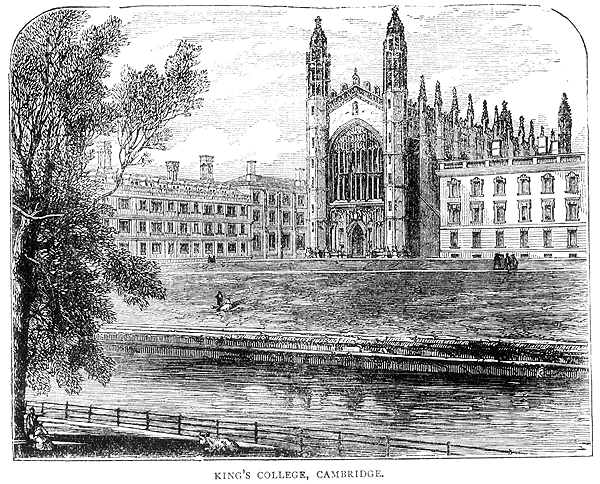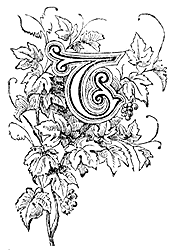The time at which this University was founded is not exactly known, but Henry I. (Beauclerk) repaired the damage done to it by Robert de Montgomery (who had ravaged the county and town with fire and sword) and bestowed many privileges on the town. He constituted it a corporation, and fixed a regular ferry over the Cam, which "brought much trading and many people thereunto." By the earlier part of the thirteenth century many scholars were assembled there; but they dwelt at a great expense in the town, and often declared that they must go elsewhere on account of the imposition of the lodging or "hostel" keepers. In 1270 Prince Edward (afterwards Edward I.) visited Cambridge, and having been told of the frequent differences between the scholars and the townsmen, he caused an instrument to be drawn up by which it was settled that thirteen University men and ten burgesses were to act in concert in seeing that peace was faithfully kept between gown and town. In 1280 there were in Cambridge thirty-four hostels and twenty inns, but very soon the scholars were to have Colleges to live in. The oldest known College in Cambridge is St. Peter's, or Peterhouse, in Trumpington Street, nearly opposite to Pembroke College. In 1257 Hugh de Balsham, subprior of Ely, bought two hostels which he intended to appropriate to the use of certain scholars kept by him in the Hospital of St. John; in 1284 he obtained from the king a license to found his college, and he removed his scholars to Trumpington Street to his two hostels. He put them in possession of these and of the Church of St. Peter's, with the tithes of its two mills; and to atone to the brethren of the hospital for taking these mills and scholars, etc., he ordained that they should have certain rents and several houses near their hospital, which he had previously given to his scholars. When he died in 1286 Hugh de Balsham by his will left to the college 300 marks for the purpose of building; with this money they erected a hall, kitchen and butteries. Balsham placed this college under the care of the Bishop of Ely, who did much for it. As it at present exists this college is not picturesque; we name it simply as the first foundation. Some eminent men, however, have been educated here, Heywood, the dramatist; Crashaw and Gray, the poets.  King's College was founded by the Royal Saint, Henry VI., in 1440. It is open only to the scholars of Eton, for whom the good king probably meant it when he established it. It soon became the largest and most important College in the University. The chapel, the work of the three Henries, VI., VII., and VIII., is one of the finest specimens of perpendicular Gothic in the world. It is three hundred and sixteen feet long, fifty wide and ninety high. "The effect on the beholder of the magnificent proportions of the massive roof of stone, hung as it were high in mid-air, of its lofty branching pillars and the entrancing beauty of its fanlike tracery and gorgeous groining is at once awe-inspiring and overpowering." 1 The stained glass windows are remarkably fine and in the best style of art. Wordsworth was inspired by this most beautiful chapel with two of his finest sonnets. Trinity College, founded by Henry VIII., has a magnificent hall; externally it presents a lofty building supported by light buttresses, with a high-pitched Flemish roof, surmounted by an elegant lantern. "The interior is a perfect picture of an old baronial hall with a raised dais, screenwork, music-gallery, butteries and adjacent kitchen. It is a hundred feet long, forty broad and fifty high, and is wainscoted in carved oak; open carved oak rafters support the roof. in the decoration of the wainscoting and the roof, gold and colour have been used with great effect." The grandeur of this hall is much increased by the coloured light that enters it from the painted windows, filled with heraldic bearings. At the upper end of the hall, just below the dais, is a deep and lofty oriel window on each side. There are some fine portraits on the walls. This college has suites of rooms for royal visitors, and the judges on circuit are lodged here. "The library is a fine building, by Sir Christopher Wren. The interior is unsurpassed by any building in the country for harmony of design. It is 190 feet long and 40 feet broad; at the south end are folding doors opening upon a balcony, from which there are fine views of country and river." 2 There are some fine statues and busts - Thorwaldsen's Byron, and a bust of Tennyson. The library is rich in controversial tracts published in the troubled seventeenth century, and it has two cases of valuable old MSS, which contain much of the poetry of Milton, written by his own hand, and a volume of mathematical papers in the writing of Sir Isaac Newton. The walks belonging to Trinity are charming. They form a rectangle, about a third of a mile in circumference, on the far side of the Cam. At the end of a fine avenue of lime trees, the branches of which meet and intersect at a great height, is seen the steeple of Coton Church. St. John's, next in size and nearest to Trinity, is built on the site of the old Hospital of St. John. The building consists of four distinct courts, and is entered from the street by a very noble gateway tower, with four corner turrets. The chapel, 120 feet long and 27 broad, is a handsome building with curious carved stalls. The hall is remarkable for height and for its carved and gilt wainscoting. There are some fine paintings here. Jesus College stands apart on the banks of the Cam at the eastern entrance of the town. its secluded situation attracted the attention of James I. when on a visit to the University, and he said "that if he lived at the University he would pray at King's, eat at Trinity, and study at Jesus." As we are chiefly describing the picturesque, we think we must here conclude our chat about Cambridge. * * * * * * 1. "Abbeys and Castles." |
||||
